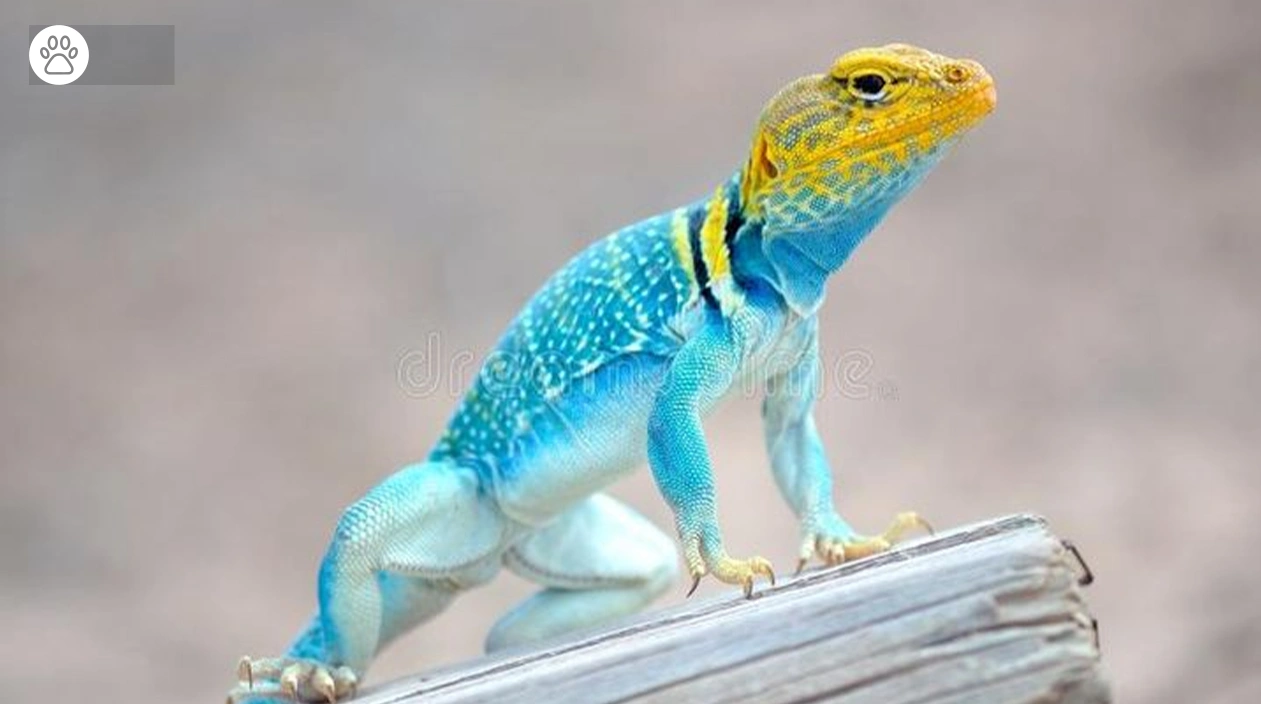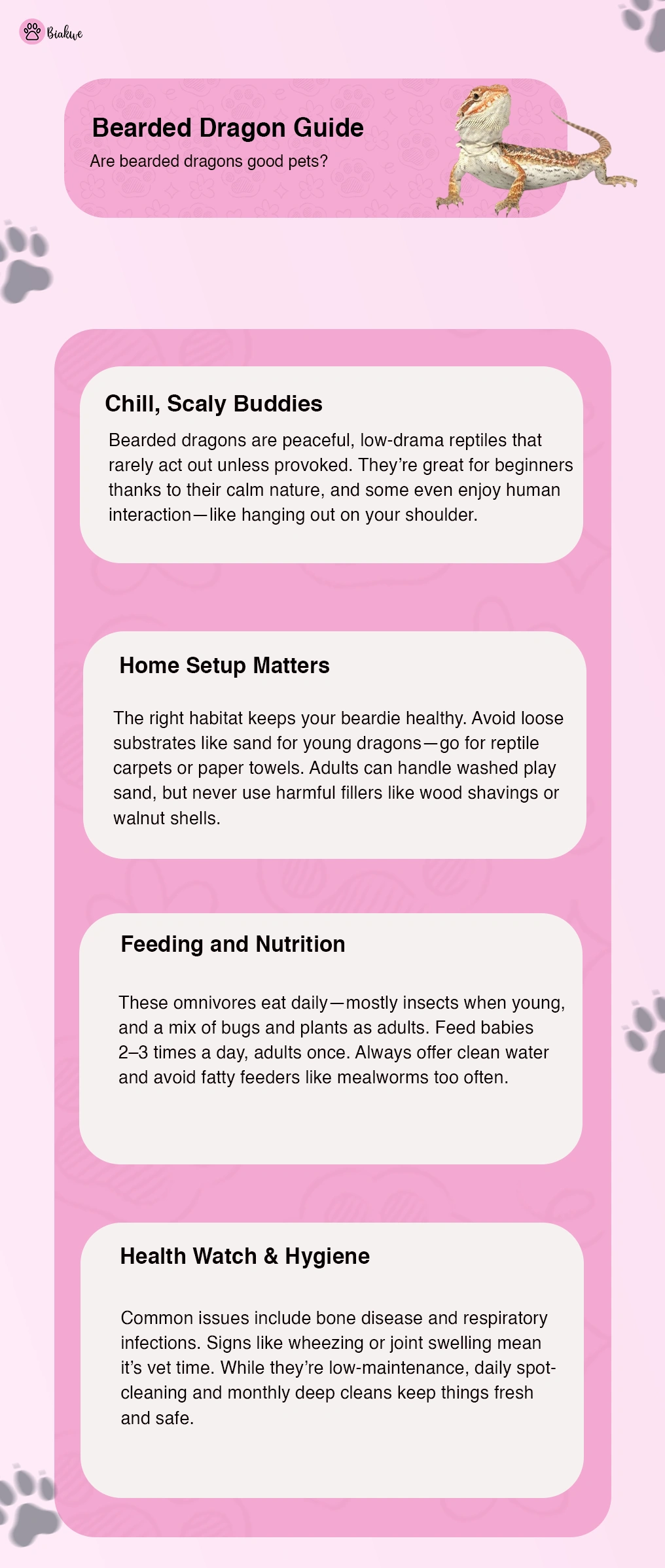A bearded dragon is a cross between an iguana and a chameleon. From its initial looks it does have the dragon feeling. But none of the ferocity. Bearded dragons are good pets because they are not aggressive. Like pandas, they just mind their own business. Unless someone pokes them. The overall complexion of these pets is scaly.
What are Bearded Dragons?
Because of the spiky formations around their necks, bearded dragons are commonly known by this moniker. These spines are flat against their skin under normal circumstances. But when a dragon senses danger, its neck will swell, raising its spines. Owners seldom notice bearded dragons acting aggressively since they are often quiet in captivity.
Being diurnal, these animals usually adjust easily to handling. Some even like to sleep on their owners’ shoulders. However, because of their territorial tendencies, male bearded dragons should be kept separate.
Visit this: Summer Doggy: Tips to Keep Your Dog Cool, Safe & Happy

Why Substrate is essential for Bearded dragon habitat?
The substance that is positioned at the base of a bearded dragon’s habitat is referred to as substrate. It may improve the enclosure’s overall natural look and atmosphere while also helping to manage humidity levels.
Because loose substrates like sand provide a significant danger of inadvertent ingestion or curiosity-driven eating, which might lead to intestinal obstructions, it is best to avoid giving young bearded dragons access to them. Reptile rugs or paper towels are suggested substitutes.
You may use washed play sand (not fine silica sand) for adult bearded dragons. But you may also use reptile rugs or paper towels. Do not use walnut shells, maize cobs, wood shavings, or any other substrates that might be harmful if consumed. Feces are readily retrieved using a cat litter scoop when using sand. Bearded dragons love digging and burrowing. They love to play hide and seek. They hate mongoose.
Check this: Natural Pain Relief for Dogs: Safe Alternatives to Medication

How Frequently Do Bearded Dragons Consume Food and Water?
Bearded dragons can munch anything you feed them. This includes insects, small animals, and plants. In a home environment, they should eat both veggies and insects. Bearded dragons eat once every 24 hours. Age can be a factor concerning their eating habits. Feeding your young pet three times a day is essential Your vet can give you insight about your baby bearded dragon.
Frequent Health and Behavioral Issues a bearded dragon faces
Metabolic bone disease is common in bearded dragons. It is caused by an imbalance between phosphorus and calcium. Bone disease is one of the main reasons they are prone to fractures. They can be susceptible to airborne diseases. Earlier signs of this are wheezing and mucus around lips and nose. Their digestive tract requires it to be cleansed. By eating mealworms you can expect them to be in pain.
Choosing Your Bearded Dragon
Due to strict laws in Australia that forbid the export of native animals, nearly all bearded dragons in the United States are grown in captivity. Bearded dragons hate captivity. You may easily get bearded dragons from reputable breeders or rescue groups. Baby dragons usually cost about $50 to $100. Select a bearded dragon with a lively personality and skin that appears healthy. Warning indications include :
Visit more: Ragdoll: Cat Breed Profile, Characteristics and Care
- Discolored skin
- Loose droppings
- Swollen joints
- Discharge around the mouth, nose, or eyes.

Bearded Dragon Guide
Choosing the right enclosure
A 75- gallon terrarium tank is what your beardie requires. Keep in mind the tank should be three times the size of your pet. The tank enclosure is only the start. Your next goal is to maintain the right ambient temps. Your tank should come with UVB lights. These help prevent any bone deformities. Covering all the basics is essential. its humidity levels need to be maintained.
Unlike other reptiles that can go without food for weeks or months. Your bearded dragon requires at least two meals a day. Its current food is worms, crickets and cockroaches.
According to research, baby bearded dragons follow the 80-20 principle. They eat 80 percent bugs and 20 percent plants. But not all things are great for bearded dragons. Almost all bearded dragons carry dangerous bacteria, Linked with food poisoning. Of course these are not fatal but you will require a proper research before even owning an adult bearded dragon. Whatever you do, don’t kiss it.
See this: How to Help Your Cat with Hairballs Naturally
Sleeping
The bearded dragon is a diurnal animal. This indicates that they sleep at night and are active throughout the day. Beardie awakens at the crack of dawn. They are naturally cold-blooded.
Handling
Smaller animals are harder to handle. as they are easier to injure larger animals. So handling a beard is not everyone’s cup of tea.
Cleaning
Bearded dragons, fortunately for you, are the low-maintenance rock stars of the lizard kingdom. These little creatures are approximately as fragrant as a bunch of roses and take personal cleanliness very seriously. To maintain the positive energy, even modest homes do need some daily attention.
It will only take a few minutes of your time every day to pick up droppings and leftover nibbles. Knowing that a thorough cleaning will only be required once or twice a month allows you to unwind with a little daily maintenance.
Feeding
As omnivores, feeding them plants and insects is advisable. As a result, you must provide your bearded dragon with a healthy diet and lots of fresh water every day. While baby bearded dragons often eat once or twice a day. Adults typically eat once.
Bearded dragons, fortunately, don’t pick and choose their food. They appreciate a wide variety of fruits, vegetables, and insects. So finding reasonably priced foods that they like is not too difficult.
Final thoughts
Many people find that bearded dragons are great companions. Both adults and older kids would love them as pets. renowned for their gregarious dispositions, vibrant personalities, and natural curiosity. Additionally, these lizards are easy to maintain and fun to watch and engage with. With right care these reptiles can survive the toughest times. However it is important for any future pet owner to do the research. They can easily become a threat if you treat them like a toy.
